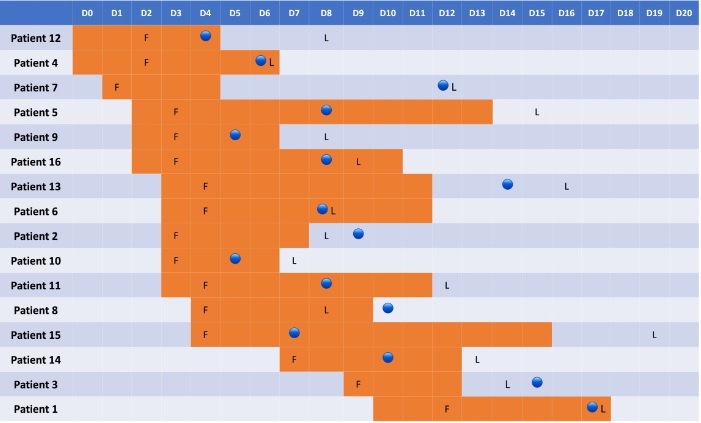Summary After symptoms resolve: A study in the American Journal of Respiratory and Critical Care Medicine indicates that the virus may be detectable up to 8 days after a person’s symptoms resolve. Half of the patients in the study still tested positive via a throat swab after their symptoms resolved.
|
SARS-CoV-2 (previously 2019-nCoV) has infected >167,000 patients and killed >6600 people. It has been reported that one patient in Germany had high viral titers after resolution of fever and infected two of the close contacts after resolution of symptoms). In the wake of these cases, it is still unclear how long a patient is positive for the virus after symptoms resolve.
In this study, we aimed to determine the temporal kinetics of viral clearance in reference to symptom resolution in 16 patients treated in Beijing, China, and show that half of the COVID-19 patients were virally positive even after resolution of your symptoms .
Cases:
We studied the 16 confirmed COVID-19 patients discharged from the Treatment Center of PLA General Hospital in Beijing, China, between January 28 and February 9, 2020.
Throat samples were collected from all patients on alternate days and analyzed.
Patients were discharged after recovery and confirmation of “viral negative” status by at least two consecutive real-time PCRs .

Kinetics of the time of viral presence in relation to the resolution of symptoms. Day 0 is the first day of symptoms, while blue dots indicate resolution of symptoms. The first orange box represents the day of the first positive viral detection and the last orange box indicates the day of the first negative viral qPCR. F and L indicate that the first and last time points were laboratory blood tests performed during hospitalization.
Discussion
The current COVID-19 pandemic is the third and deadliest coronavirus outbreak in the 21st century, where the number of infections and mortality has surpassed MERS and SARS infections in a short period. Although the infection appears to be milder with the highest fatality in the older male population with pre-existing morbidities, it is highly contagious.
The ability to spread may arise from the ability of the virus to transmit from subclinical patients.
Cases have been reported where a patient could infect close contacts even after "apparent recovery" from the infection. This warrants us investigating the "detachment window" after the patient’s clinical recovery. In this study, we report that half of the patients remained viral positive even after resolution of symptoms for up to eight days .
The kinetics of viral elimination were similar in another study by Young et al (12 days), where all patients survived the infection. In contrast, the virus persisted for 20 days in another study, which had a significant high mortality of >40%. This information can provide a useful tool for doctors and policymakers to ensure that recovered patients do not spread the virus.
It is important to note that all of our patients had milder infections that recovered from the illness. However, it is currently unclear whether there is delayed viral clearance in the more vulnerable population, such as those who are older or have immune deficiencies or are on immunosuppressive therapies.
The current data are mostly derived from young and male subjects, which is consistent with our previous report in Beijing. Similar to the previous study, here, we also demonstrate another child (3-year-old male) with COVID-19 indicating the ability of this virus to infect young children as recently described.
Our study is limited by the number of patients, as there have been limited cases outside the epicenter of the coronavirus outbreak that have been successfully treated so far to be discharged from hospital.
|
















